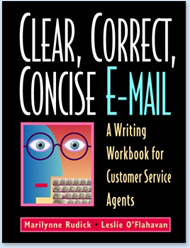![]() You know that scene in the heist movie? The one that comes right after the criminals rob the bank but right before the cops bust in? When the ringleader says, “We’ve got to get our stories straight or we’re all going to jail for a long, long time…”
You know that scene in the heist movie? The one that comes right after the criminals rob the bank but right before the cops bust in? When the ringleader says, “We’ve got to get our stories straight or we’re all going to jail for a long, long time…”
Aside from committing robbery and being pursued by cops, etc., we in the customer care world have become like those criminals. In the hectic rush to respond to customers in their channel of choice, we’re not getting our stories straight. We’re giving customers different answers over the phone than we give in live chat. We’re making customers wait days to hear from us via email, but we’re answering them in minutes over social. Our onshore teams write in a different style than our offshore teams. This inconsistent communication increases contact volume, exhausts agents, and fractures the customer experience.
Why our communications with customers are inconsistent
- We’re imprisoned in a Customer Service Caste System. We have a “shiny new channel” problem, and it causes us to exalt the people who work in the newer channels, such as social media, over the people who work in the established ones. In fact, working in a newer channel is often presented as an incentive for agents who have been answering calls or emails. “Oh yeah, my agents love chat. I mean, they love anything that gets them off the phones, am I right?” But when we don’t treat channels as equally important to our operation, or the people who work in those channels as equally skilled or “cool,” we introduce inconsistency. Agents who work in a shiny new channel realize their work gets more attention from upper management. This spotlight may encourage these agents to bend rules or abandon procedures to keep customers, and the attentive CEO, happy.
. - We allow frontline agents to believe it’s their individual responsibility to protect the company’s bottom line. Passionate frontline agents are the foundation of any customer service operation. And people who are strongly loyal to their company naturally seek to protect its bottom line against customers who are refund hounds, compensation seekers, or coupon grabbers. But agents can be erratic or overzealous in their efforts to protect the company from getting ripped off, and they can respond generously to one person and stingily to the next. It’s not an individual agent’s responsibility to gauge whether resolving a customer’s problem is too costly for the company or worth the money. When agents take on the spend-or-save role, their answers are all over the place.
. - We receive customer contacts in one channel but answer them in another. Does your customer service team respond to tweets by asking the customer to dial the 800 number? Do your live chat agents explain to customers that questions about product warranties must be emailed in? If so, you’re playing a dangerous game of telephone (pardon the lame joke). The more hand-offs agents and customers experience, the more likely inconsistences are. It’s difficult to give the customer the same answer when the customer’s restating the request numerous times.
. - Customer service agents create their own knowledge stashes instead of using the shared one. If your agents keep a secret stash of office candy, and they’re willing to share, that’s a very good thing. But if they keep a secret stash of knowledge on their own computers instead of relying on the shared, vetted, current, correct info in your knowledgebase, that’s a very bad thing. Highly motivated agents and stuck-in-the-mud agents alike create stashes of their own email templates or social media responses, which they copy-and-paste as needed. Of course, there’s no quicker way to create inconsistencies than to use different knowledge sources. As their manager, you need to insist they stop using their private supply.
How to make our communications with customers (more) consistent
- Love—and invest in—channels equally. While a shiny new channel may initially need more of your budget and attention, that channel isn’t inherently cooler or better than the established channels. Don’t understaff the phone channel, and keep customers waiting in queue, while you hire staff for the sparkly channels like chat and SMS. To inspire consistently excellent work from all agents in all channels, you must value the work agents do in each channel equally.
. - Give agents clear, consistent instructions about spending the company’s money to retain customers. Agents can’t possibly know whether a one-time refund of $50 is harmful to the bottom line, and we don’t want them to presume they know whether it is. Make your guidance about how to compensate customers extremely clear. If you allow your agents broad decision-making in this regard, that’s fine. Just explain to agents that they will focus on individual customers, while you (and other company honchos) will focus on financial solvency. Agents can be consistent in their approach to compensating customers without being identical in the amounts they give. But they’re bound to be dangerously inconsistent if they believe it’s their role to protect the company from financial ruin.
. - Answer the customer’s question in the channel it was received. While privacy concerns may prevent you from answering customer’s banking questions on a public Facebook page, in most cases, it’s possible to answer customers’ questions in the channel they chose. To do so, the agents that staff each channel will need the same product knowledge, access to the same tools, and the same amount of responsibility. Do you see how many times the word “same” appears in the last sentence? This same-ness in agent expertise will result in consistent responses to customers in the channel they chose and across channels.
. - Ensure your knowledgebase is clean, current, and usable. If you want agents to give consistent answers, they must draw from the same information source, and that should be your knowledgebase. While we might want to high-five them for their initiative, agents who create their own knowledge stashes are causing big problems. If lots of your agents have their own knowledge sources on their own hard drives, you may have to organize a knowledge confiscation effort, in which you tell agents you’ll review their copy-and-paste items and include them in the KB if they’re accurate and well written, but that they must stop using their own knowledge by a certain date. Granted, this “I have my own templates” behavior is a difficult one to stamp out, but a well-maintained knowledgebase or template library is the only way to do it.
Inconsistencies aren’t just bad for customers; they’re bad for customer service teams too. Inconsistent answers increase contact volume because they motivate customers to fish for the answers they want instead of the answer they received. Inconsistencies create the classic “Dad said no, so I’ll ask Mom” situation. And inconsistent communications harm managers’ efforts to get the best performance from agents. They sow the idea that the right way is a matter of opinion, that the boss is capricious, that quality scoring is unfair.
It’s not true that consistent communication is always excellent. But it is true that inconsistent communication is never excellent.
Tags: Customer service, Omnichannel, Social Customer Service






Thanks for this update.